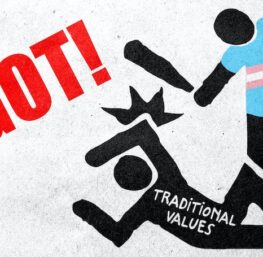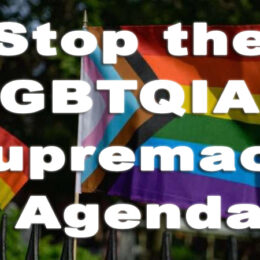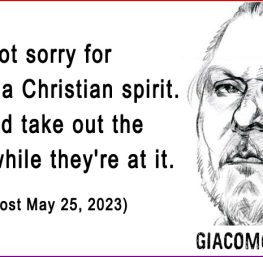OrthodoxyToday | by Frank Ellis | Oct. 23, 2009
No successful society shows a spontaneous tendency towards multiculturalism or multiracialism. Successful and enduring societies show a high degree of homogeneity. Those who support multiculturalism either do not know this or, what is more likely, realize that if they are to transform Western societies into strictly regulated, racial-feminist bureaucracies they must first undermine those societies.
This transformation is as radical and revolutionary as the project to establish Communism in the Soviet Union. Just as every aspect of life had to be brought under political control in order for the commissars to impose their vision of society, the multiculturalists hope to control and dominate every aspect of our lives. Unlike the hard tyranny of the Soviets, theirs is a softer, gentler tyranny but one with which they hope to bind us as tightly as a prisoner in the Gulag. Today’s “political correctness” is the direct descendent of Communist terror and brainwashing.
Unlike the obviously alien implantation that was Communism, what makes multiculturalism particularly insidious and difficult to combat is that it usurps the moral and intellectual infrastructure of the West. Although it claims to champion the deepest held beliefs of the West, it is in fact a perversion and systematic undermining of the very idea of the West.
What we call “political correctness” actually dates back to the Soviet Union of the 1920s (politicheskaya pravil’nost’ in Russian), and was the extension of political control to education, psychiatry, ethics, and behavior. It was an essential component of the attempt to make sure all aspects of life were consistent with ideological orthodoxy – which is the distinctive feature of all totalitarianisms. In the post-Stalin period, political correctness even meant that dissent was seen as a symptom of mental illness, for which the only treatment was incarceration.
As Mao Tse-Tung, the Great Helmsman, put it, “Not to have a correct political orientation is like not having a soul.” Mao’s “Little Red Book” is full of exhortations to follow the correct path of Communist thought, and by the late 1960s Maoist political correctness was well established in American universities. The final stage of development, which we are witnessing now, is the result of cross-fertilization with all the latest “isms:” anti-racism, feminism, structuralism, and post-modernism, which now dominate university curricula. The result is a new and virulent strain of totalitarianism, whose parallels to the Communist era are obvious. Today’s dogmas have led to rigid requirements of language, thought, and behavior, and violators are treated as if they were mentally unbalanced, just as Soviet dissidents were.
Some have argued that it is unfair to describe Stalin’s regime as “totalitarian,” pointing out that one man, no matter how ruthlessly he exercised power, could not control all the functions of the state. But, in fact, he didn’t have to. Totalitarianism was much more than state terror, censorship, and concentration camps; it was a state of mind in which the very idea of a private opinion or point of view had been destroyed. The totalitarian propagandist forces people to believe that slavery is freedom, squalor is bounty, ignorance is knowledge, and that a rigidly closed society is the most open in the world. And once enough people are made to think this way, it is functionally totalitarian even if a single dictator does not personally control everything.
Today, of course, we are made to believe that diversity is strength, perversity is virtue, success is oppression, and that relentlessly repeating these ideas over and over is “tolerance and diversity.” Indeed, the multicultural revolution works subversion everywhere, just as Communist revolutions did: judicial activism undermines the rule of law; “tolerance” weakens the conditions that make real tolerance possible; universities, which should be havens of free inquiry, practice censorship that rivals that of the Soviets. At the same time, we find a relentless drive for equality:
The Bible, Shakespeare, and rap “music” are just texts with “equally valid perspectives;” deviant and criminal behavior is an “alternative life-style.”
Today, Dostoevsky’s “Crime and Punishment” would have to be repackaged as “Crime and Counseling.”
In the Communist era, the totalitarian state was built on violence. The purges of the 1930s and the Great Terror (which was Mao’s model for the Cultural Revolution) used violence against “class enemies” to compel loyalty. Party members signed death warrants for “enemies of the people” knowing that the accused were innocent, but believing in the correctness of the charges. In the 1930s, collective guilt justified murdering millions of Russian peasants. As cited by Robert Conquest in “The Harvest of Sorrow: Soviet Collectivization and the Terror-Famine” (p. 143), the state’s view of this class was, “not one of them was guilty of anything; but they belonged to a class that was guilty of everything.” Stigmatizing entire institutions and groups makes it much easier to carry out wholesale change.
This, of course, is the beauty of “racism” and “sexism” for today’s culture attackers – sin can be extended far beyond individuals to include institutions, literature, language, history, laws, customs, entire civilizations.
The charge of “institutional racism” is no different from declaring an entire economic class an enemy of the people. “Racism” and “sexism” are multiculturalism’s assault weapons, its Big Ideas, just as class warfare was for Communists, and the effects are the same.
If a crime can be collectivized all can be guilty because they belong to the wrong group. When young whites are victims of racial preferences they are today’s version of the Russian peasants. Even if they themselves have never oppressed anyone they “belong to the race that is guilty of everything.”
The purpose of these multi-cultural campaigns is to destroy the self. The mouth moves, the right gestures follow, but they are the mouth and gestures of a zombie, the new Soviet man or, today, PC-man. And once enough people have been conditioned this way, violence is no longer necessary. We reach steady-state totalitarianism, in which the vast majority know what is expected of them and play their allotted roles.
The Russian experiment with revolution and totalitarian social engineering has been fully chronicled by two of that country’s greatest writers, Dostoevsky and Solzhenitsyn. They brilliantly dissect the methods and psychology of totalitarian control. Dostoevsky’s “Devils (Oxford World’s Classics)” has no equal as a penetrating and disturbing analysis of the revolutionary and utopian mind.
The “devils” are radical students of the middle and upper classes flirting with something they do not understand. The ruling class tries to ingratiate itself with them. The universities have essentially declared war on society at large. The great cry of the student radicals is freedom: freedom from the established norms of society, freedom from manners, freedom from inequality, freedom from the past.
Russia’s descent into vice and insanity is a powerful warning of what happens when a nation declares war on the past in the hope of building a terrestrial paradise. Dostoevsky did not live to see the abominations he predicted but Solzhenitsyn experienced them first hand.
“The Gulag Archipelago” and “August 1914” can be seen as histories of ideas, as attempts to account for the dreadful fate that befell Russia after 1917. Solzhenitsyn identifies education and the way teachers saw their duty as instilling hostility to all forms of traditional authority as the major factors that explain why Russia’s youth was seduced by revolutionary ideas. In the West, during the 1960s and 1970s – which can collectively be called “the 60s” – we hear a powerful echo of the collective mental capitulation of Russia that took place in the 1870s and continued through the revolution.
One of the echoes of Marxism that continues to reverberate today is the idea that truth resides in class (or sex or race or erotic orientation). Truth is not something to be established by rational inquiry, but depends on the perspective of the speaker. In the multicultural universe, a person’s perspective is “valued” (a favorite word) according to class. Feminists, blacks, environmentalists and homosexuals have a greater claim to truth because they are “oppressed.” In the misery of “oppression” they see truth more clearly than the white heterosexual men who “oppress” them. This is a perfect mirror image of the Marxist proletariat’s moral and intellectual superiority over the bourgeoisie. Today, “oppression” confers a “privileged perspective” that is essentially infallible. To borrow an expression from Robert Bork’s “Slouching Towards Gomorrah,” black and feminist activists are “case-hardened against logical argument” – just as Communist true believers were.
Indeed, feminist and anti-racist activists openly reject objective truth. Confident that they have intimidated their opposition, feminists are able to make all kinds of demands on the assumption that men and women are equal in every way. When outcomes do not match that belief, this is only more evidence of white-male deviltry.
One of the most depressing sights in the West today, particularly in the universities and in the media, is the readiness to treat feminism as a major contribution to knowledge and to submit to its absurdities. Remarkably, this requires no physical violence. It is the desire to be accepted that makes people truckle to these middle-class, would-be revolutionaries. Peter Verkhovensky, who orchestrates murder and mayhem in The Devils, expresses it with admirable contempt: “All I have to do is to raise my voice and tell them that they are not sufficiently liberal.” The race hustlers, of course, play the same game: Accuse a late-20th century liberal of “racism” or “sexism” and watch him fall apart in an orgy of self-flagellation and Maoist self-criticism. Even “conservatives” wilt at the sound of those words.
Ancient liberties and assumptions of innocence mean nothing when it comes to “racism:” You are guilty until proven innocent, which is nearly impossible, and even then you are forever suspect. An accusation of “racism” has much the same effect as an accusation of witchcraft did in 17th century Salem.
It is the power of the charge of “racism” that stifles the derision that would otherwise meet the idea that we should “value diversity.” If “diversity” had real benefits whites would want more of it, and would ask that yet more cities in the U.S. and Europe be handed over to immigrants. Of course, they are not rushing to embrace diversity and multiculturalism; they are in headlong flight in the opposite direction. Valuing diversity is a hobby for people who do not have to endure its benefits.
A multicultural society is one that is inherently prone to conflict, not harmony. This is why we see a huge growth in government bureaucracies dedicated to resolving disputes along racial and cultural lines. These disputes can never be resolved permanently because the bureaucrats deny one of the major causes: race. This is why there is so much talk of the “multicultural” rather than the more precise “multiracial.” Ever more changes and legislation are introduced to make the host society ever more congenial to racial minorities. This only creates more demands, and encourages the non-shooting war against whites, their civilization, and even the idea of the West.
How is such a radical program carried forward? The Soviet Union had a massive system of censorship – the Communists even censored street maps – and it is worth noting there were two kinds of censorship: the blatant censorship of state agencies and the more subtle self-censorship that the inhabitants of “peoples democracies” soon learned.
The situation in the West is not so straightforward. There is nothing remotely comparable to Soviet-style government censorship and yet we have deliberate suppression of dissent. Arthur Jensen, Hans Eysenck, J. Philippe Rushton, Chris Brand, Michael Levin, and Glayde Whitney have all been vilified for their racial views. The case of Prof. Rushton is particularly troubling because his academic work was investigated by the police. The attempt to silence him was based on provisions of Canadian hate speech laws. This is just the sort of intellectual terror one expected in the old Soviet Union. To find it in a country that prides itself on being a pillar of Western liberal democracy is one of the most disturbing consequences of multiculturalism.
A mode of opinion control softer than outright censorship is the current obsession with fictional role models. Today, the feminist and anti-racist theme is constantly worked into movies and television as examples of Bartold Brecht’s principle that the Marxist artist must show the world not as it is but as it ought to be. This is why we have so many screen portrayals of wise black judges; street-wise, straight-shooting lady policemen; minority computer geniuses; and, of course, degenerate white men. This is almost a direct borrowing from Soviet-style socialist realism, with its idealized depictions of sturdy proletarians routing capitalist vermin.
Multiculturalism has the same ambitions as Soviet Communism. It is absolutist in the pursuit of its various agendas, yet it relativizes all other perspectives in its attack on its enemies. Multiculturalism is an ideology to end all other ideologies, and these totalitarian aspirations permit us to draw two conclusions: First, multiculturalism must eliminate all opposition everywhere. There can be no safe havens for counter-revolutionaries. Second, once it is established the multicultural paradise must be defended at all costs. Orthodoxy must be maintained with all the resources of the state.
Such a society would be well on its way to becoming totalitarian. It might not have concentration camps, but it would have re-education centers and sensitivity training for those sad creatures who still engaged in “white-male hegemonic discourse.” Rather than the hard totalitarianism of the Soviet state we would have a softer version in which our minds would be wards of the state. We would be liberated from the burden of thought and therefore unable to fall into the heresy of political incorrectness.
If we think of multiculturalism as yet another manifestation of 20th century totalitarianism, can we take solace in the fact that the Soviet Union eventually collapsed? Is multiculturalism a phase, a periodic crisis through which the West is passing, or does it represent something fundamental and perhaps irreversible?
Despite the efforts of pro-Soviet elements, the West recognized the Soviet empire as a threat. It does not recognize multiculturalism as a threat in the same way. For this reason, many of its assumptions and objectives remain unchallenged. Still, there are some grounds for optimism, for example, the speed with which the term “political correctness” caught on. It took the tenured radicals completely by surprise, but it is only a small gain.
In the long term, the most important battleground in the war against multiculturalism is the United States. The struggle is likely to be a slow, frustrating war of attrition. If it fails, the insanity of multiculturalism is something white Americans will have to live with. Of course, at some point whites may demand an end to being punished because of black failure. As Prof. Michael Hart argues in “The Real American Dilemma” (published by New Century Foundation and available from American Renaissance (http://www.amren.com) for $11.95, postage paid), there could be racial partition of the United States. We may find that what happened in the Balkans is not peculiar to that part of the world. Race war is not something the affluent radicals deliberately seek but their policies are pushing us in that direction.
. . . more




Good article. Diversity isn’t a strength like we’re told everyday, but a liability, constant source of conflict, and often leads to the destruction of nations.